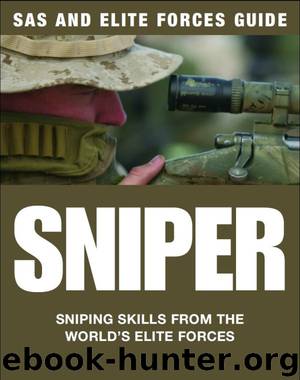Sniper by Martin J. Dougherty

Author:Martin J. Dougherty [Dougherty, Martin J.]
Language: eng
Format: epub
Published: 2012-08-10T00:00:00+00:00
The ballistic path of a bullet is not perfectly symmetrical; drag from the air slows the round as it flies, causing its descent to be steeper than its rise. The retained velocity of the round when it reaches the target will thus be less than its muzzle velocity. Wind effects can cause side-to-side departure from the line of sight, and can increase or decrease the steepness of the bullet’s arc if blowing towards or away from the target.
On a very long shot, wind calculations become highly complex. The strength and even the direction of wind can vary over the distance covered by a long shot, and there may also be eddies around the corners of buildings or other objects. Air temperature and humidity also affect a shot by changing the amount of drag the air exerts on the bullet as it passes through. More drag means that the round will lose energy sooner, falling a little shorter. Air temperature can also create optical effects that make a target seem closer or further away.
A sniper needs to be able to estimate the aggregate effect of these many factors on his shot, at the precise moment he squeezes the trigger. The only way to learn to do this is from experience. The sniper must make many, many long shots under varying conditions, with a spotter to tell him where the round actually went. This data is recorded on a card, allowing the sniper to gradually build up a feeling for the many factors that might affect his bullet in flight.
All snipers are taught to estimate wind speed from the movement of vegetation or litter, and how this will affect a bullet in flight. Yet, even with all this knowledge, picking an aim point is something of a ‘black art’, with some snipers being instinctively better at it than others, sometimes without really understanding why they can fit all the pieces together to create a perfect shot.
Rifle Characteristics
Most civilian target shooters and combat troops will fire repeated shots from their weapon, which causes a small amount of fouling due to unburned propellant. They will also be firing from a hot barrel most of the time. The effects of these factors on accuracy are small, but significant over a long distance. A sniper will often fire only one shot, and will thus shoot from a clean, cold barrel. He needs to be aware of the characteristics his rifle possesses with a cold clean barrel and how they will change if he has to take several shots. Like other skills, this is a matter of experience gained in many, many shots.
Leading, Tracking and Trapping
Download
This site does not store any files on its server. We only index and link to content provided by other sites. Please contact the content providers to delete copyright contents if any and email us, we'll remove relevant links or contents immediately.
Unwinding Anxiety by Judson Brewer(72708)
The Art of Coaching by Elena Aguilar(52881)
The Fast Metabolism Diet Cookbook by Haylie Pomroy(21041)
Rewire Your Anxious Brain by Catherine M. Pittman(18527)
Healthy Aging For Dummies by Brent Agin & Sharon Perkins RN(16983)
Talking to Strangers by Malcolm Gladwell(13182)
The Art of Thinking Clearly by Rolf Dobelli(10172)
Mindhunter: Inside the FBI's Elite Serial Crime Unit by John E. Douglas & Mark Olshaker(9155)
Crazy Rich Asians by Kevin Kwan(9145)
The Compound Effect by Darren Hardy(8784)
Tools of Titans by Timothy Ferriss(8183)
Periodization Training for Sports by Tudor Bompa(8144)
Becoming Supernatural by Dr. Joe Dispenza(8086)
Wonder by R. J. Palacio(7966)
Crystal Healing for Women by Mariah K. Lyons(7842)
Bodyweight Strength Training by Jay Cardiello(7825)
Therapeutic Modalities for Musculoskeletal Injuries, 4E by Craig R. Denegar & Ethan Saliba & Susan Saliba(7675)
Change Your Questions, Change Your Life by Marilee Adams(7609)
Should I Stay or Should I Go? by Ramani Durvasula(7536)
